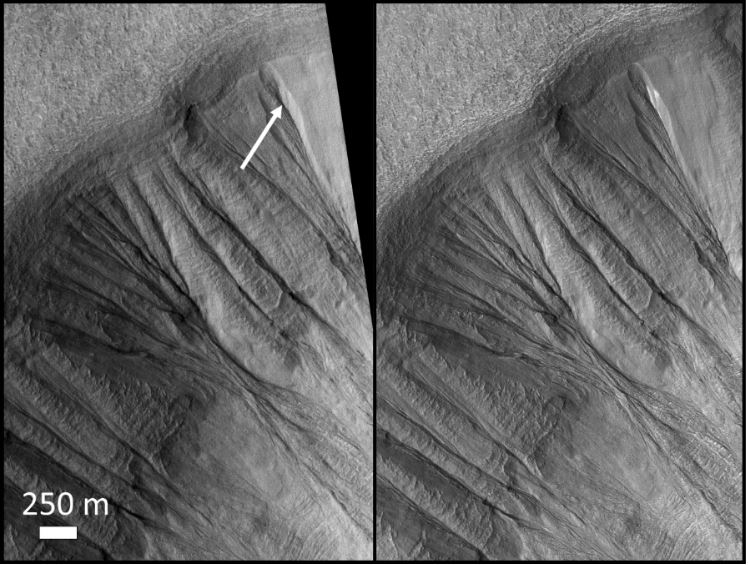Melting dusty ice may have carved Martian gullies

False-color image of light-toned, dusty water ice (relatively white materials in this image) exposed within mid-latitude Martian gullies. This ice might melt to form the gullies. Credit: NASA/JPL/University of Arizona
By analyzing the occurrences of exposed dusty ice on Mars using data from NASA’s Mars Reconnaissance Orbiter, ASU planetary scientists Aditya Khuller and Philip Christensen have found the lowest latitude detection of dusty water ice on Mars.
The melting of this dusty water ice could have led to the formation of gullies that have eroded into rock and ice at these locations and may provide places for any surviving life to exist on Mars. The results of their findings have been recently published in AGU’s Journal of Geophysical Research: Planets.
“We’ve known that Mars has water ice for a while,” said lead author Khuller, who is a graduate student at ASU’s School of Earth and Space Exploration. “But this is the first time we’ve seen it this close to the equator at places where it might be melting.”
Almost two decades ago, Christensen, a Regents Professor at ASU, noticed smooth deposits that looked like snow-packs blanketed by dirt on gullied slopes. These observations led Christensen to propose that the gullies formed by dusty snowmelt. This theory was backed by computer simulations showing that snow on Mars melts only when it is dusty.
When Khuller began analyzing new, high-resolution images of the gullies that Christensen had studied, he observed a notable change.
“There were these light-toned deposits now visible within the gullies that weren’t there in Christensen’s original observations,” said Khuller. “The light-toned deposits were present at the exact locations Christensen had proposed they would be nearly 20 years ago.”
Observing this, Khuller set about expanding his analysis and found even more of the places where the light-toned deposits were visible.

(Left) Low-resolution image used by Christensen (2003), with a remnant of the snow mantle (arrow) proposed to be the source of water that eroded these gullies. Credit: NASA/JPL/Malin Space Science Systems. (Right) New high-resolution image of the same location about 10 years later, where Khuller and Christensen believe that dusty water ice is being exposed, and potentially melting. Credit: NASA/JPL/University of Arizona
For his observations, Khuller used a geospatial information system called Java Mission-planning and Analysis for Remote Sensing (JMARS), which was developed by ASU's Mars Space Flight Facility. This award-winning system, which is available to the public, provides mission planning and data-analysis tools for NASA scientists, instrument team members and students of all ages.
Based on the brightness of the deposits, Khuller and Christensen determined that they must be dusty water ice (which has the appearance of what dirty snow looks like on Earth) because it is unlikely for short-term localized dust deposits to form only within the smooth deposits. In addition, the locations of these deposits are too warm for the ice to be water frost.
This discovery could help scientists narrow down places on Mars that might host life, because small amounts of liquid water might be produced within these water ice deposits in the summertime. And, because they are closer to the equator, the locations are also warmer, so astronauts in the future might be able to access them more easily — even with just a shovel.
“For decades, scientists have been looking for places on Mars where there could be water,” said Khuller. “We believe that these dusty ice deposits are the best candidates to look for small amounts of shallow liquid water, and therefore potentially ideal locations for any surviving life on Mars.”
Khuller and Christensen plan to develop new computer simulations of how this water ice changes with time, and they will continue to document more locations with exposed ice so that future Mars missions could potentially target them.
More Science and technology

Breakthrough copper alloy achieves unprecedented high-temperature performance
A team of researchers from Arizona State University, the U.S. Army Research Laboratory, Lehigh University and Louisiana State…

4 ASU researchers named senior members of the National Academy of Inventors
The National Academy of Inventors recently named four Arizona State University researchers as senior members to the prestigious…

Transforming Arizona’s highways for a smoother drive
Imagine you’re driving down a smooth stretch of road. Your tires have firm traction. There are no potholes you need to swerve to…

